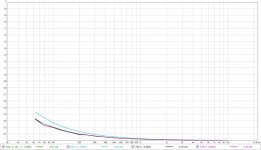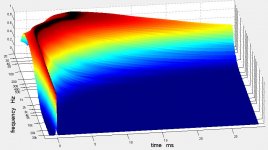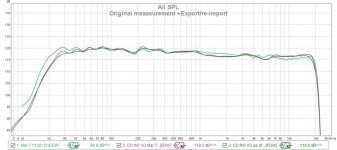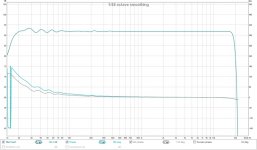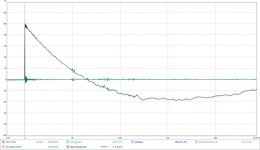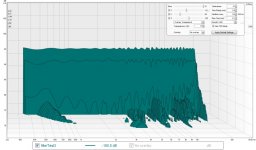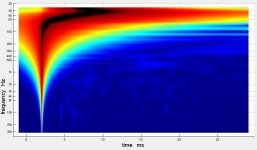OK, got the REW IR delays working...
and I've got the 1/3 octave filter at 1 Khz set. Under what tab do I find the superimposed tone burst on your next image?
and I've got the 1/3 octave filter at 1 Khz set. Under what tab do I find the superimposed tone burst on your next image?
If you have both drivers filtered like that, the IR tab shows the wave shapes. So to look at more than one simultaneously, first click on the Overlays, then select the Impulse (IR) tab there. In the legend deselect the other measurements to only see the two of interest.
Last edited:
Your new wave file does not seem to be a complete or a valid measurement. DRC-FIR is unable to process it completely with my current settings. How was this file created? I don't feel like investigating this as it does look suspect in REW. That's not a real measurement, is it?
But what it does: Adjust FR as good as possible to the (chosen) target curve and phase to follow minimum phase for a 1/6 octave frequency dependent window (which shows a lot more detail than the same window size within REW). In the low end a different (much shorter) frequency dependent window is used to remove excess phase.
That's it in a nutshell. It's way more complicated than that though, but for that just read the DRC-FIR documentation first: DRC: Digital Room Correction
Even though DRC does a marvellous job, I personally don't stop there. 😱
Based on information I gather around the listening spot I manually clean up some things that DRC-FIR does.
You can get close to the same level of performance with RePhase and some manual tweaks.
Just look at the IR of that last wave file you uploaded, Import it in REW and open up the EQ part within REW. In the bottom half, generate the waterfall plot. Now open up an "EQ filters" panel and EQ that waterfall to be flat. Don't pay too much attention to the FR at first, select frequencies in that waterfall plot that stand out. That's pretty much the best look at that first wave front to hit your ears. You'll notice EQ-ing that waterfall to flat will start to get rid of the ridges in the waterfall plot. As long as these ridges are from the driver, we are actually correcting it. If it's diffraction/reflection we are only EQ-ing for a single spot in space where the microphone was.
You can save and load settings in the "EQ Filter" panel and I've done an example adjustment, just unpack the example.rew file attached here and load that into the "EQ Filters" panel to see what I did.
I only clean up the waterfall, and check the results at the IR tab in that bottom part of the EQ panel. If it cleans up the IR, the measurement will improve. You'll notice the predicted frequency will start to look prettier as well.
If I am informed correctly you can pass these EQ settings for REW on to RePhase nowadays. So you could add tweaks like this to your RePhase correction.
Be warned: you can EQ out a reflection (well, close anyway) at a single spot. But things will get worse at other spots if you do. Only fix that waterfall's upper ridge, that's actually less of a chance you are EQ-ing later reflections. Get clean measurements to play with. Maybe even use multiple measurements taken around the listening spot and average them after setting the timing the same on each of them.
Sounds like a lot of work? It is, but you will be rewarded. 🙂
One more thing to add: see how simple IIR filters clean up that waterfall plot? Remember that if you clean up phase with Rephase, based on a 500 ms REW file! that will have an effect on the output. The relation between phase and FR is real, clean up an FR dip and you clean up it's phase response. Remember that when you try to EQ phase alone, Are you really improving both FR and Phase that way? As long as a driver acts like a minimum phase device, all that is needed are IIR filters to correct it. So be aware of what you are "fixing". Do it wrong and you're not fixing anything!
I'm a fan of the frequency dependent windows for a reason. Don't EQ the room. Fix it the old fashioned way with damping, absorption and diffusion. Fix the speaker with EQ, not the room.
But what it does: Adjust FR as good as possible to the (chosen) target curve and phase to follow minimum phase for a 1/6 octave frequency dependent window (which shows a lot more detail than the same window size within REW). In the low end a different (much shorter) frequency dependent window is used to remove excess phase.
That's it in a nutshell. It's way more complicated than that though, but for that just read the DRC-FIR documentation first: DRC: Digital Room Correction
Even though DRC does a marvellous job, I personally don't stop there. 😱
Based on information I gather around the listening spot I manually clean up some things that DRC-FIR does.
You can get close to the same level of performance with RePhase and some manual tweaks.
Just look at the IR of that last wave file you uploaded, Import it in REW and open up the EQ part within REW. In the bottom half, generate the waterfall plot. Now open up an "EQ filters" panel and EQ that waterfall to be flat. Don't pay too much attention to the FR at first, select frequencies in that waterfall plot that stand out. That's pretty much the best look at that first wave front to hit your ears. You'll notice EQ-ing that waterfall to flat will start to get rid of the ridges in the waterfall plot. As long as these ridges are from the driver, we are actually correcting it. If it's diffraction/reflection we are only EQ-ing for a single spot in space where the microphone was.
You can save and load settings in the "EQ Filter" panel and I've done an example adjustment, just unpack the example.rew file attached here and load that into the "EQ Filters" panel to see what I did.
I only clean up the waterfall, and check the results at the IR tab in that bottom part of the EQ panel. If it cleans up the IR, the measurement will improve. You'll notice the predicted frequency will start to look prettier as well.
If I am informed correctly you can pass these EQ settings for REW on to RePhase nowadays. So you could add tweaks like this to your RePhase correction.
Be warned: you can EQ out a reflection (well, close anyway) at a single spot. But things will get worse at other spots if you do. Only fix that waterfall's upper ridge, that's actually less of a chance you are EQ-ing later reflections. Get clean measurements to play with. Maybe even use multiple measurements taken around the listening spot and average them after setting the timing the same on each of them.
Sounds like a lot of work? It is, but you will be rewarded. 🙂
One more thing to add: see how simple IIR filters clean up that waterfall plot? Remember that if you clean up phase with Rephase, based on a 500 ms REW file! that will have an effect on the output. The relation between phase and FR is real, clean up an FR dip and you clean up it's phase response. Remember that when you try to EQ phase alone, Are you really improving both FR and Phase that way? As long as a driver acts like a minimum phase device, all that is needed are IIR filters to correct it. So be aware of what you are "fixing". Do it wrong and you're not fixing anything!
I'm a fan of the frequency dependent windows for a reason. Don't EQ the room. Fix it the old fashioned way with damping, absorption and diffusion. Fix the speaker with EQ, not the room.
Attachments
Last edited:
What room did you find that gives these kind of RT60 graphs 🙂

I bet record producers as well as speaker designers everywhere would like to know 🙂.
I think you may have chosen the wrong file by mistake, here is how it looks in APL:

Very different from what you've shown to be as measured.
I bet record producers as well as speaker designers everywhere would like to know 🙂.
I think you may have chosen the wrong file by mistake, here is how it looks in APL:
Very different from what you've shown to be as measured.
Attachments
Last edited:
No way, this one lacks any room response. just a deep blue sea 🙂
Not even a 1 M measurement will be like that 🙂
Compare that to your graph a page ago:
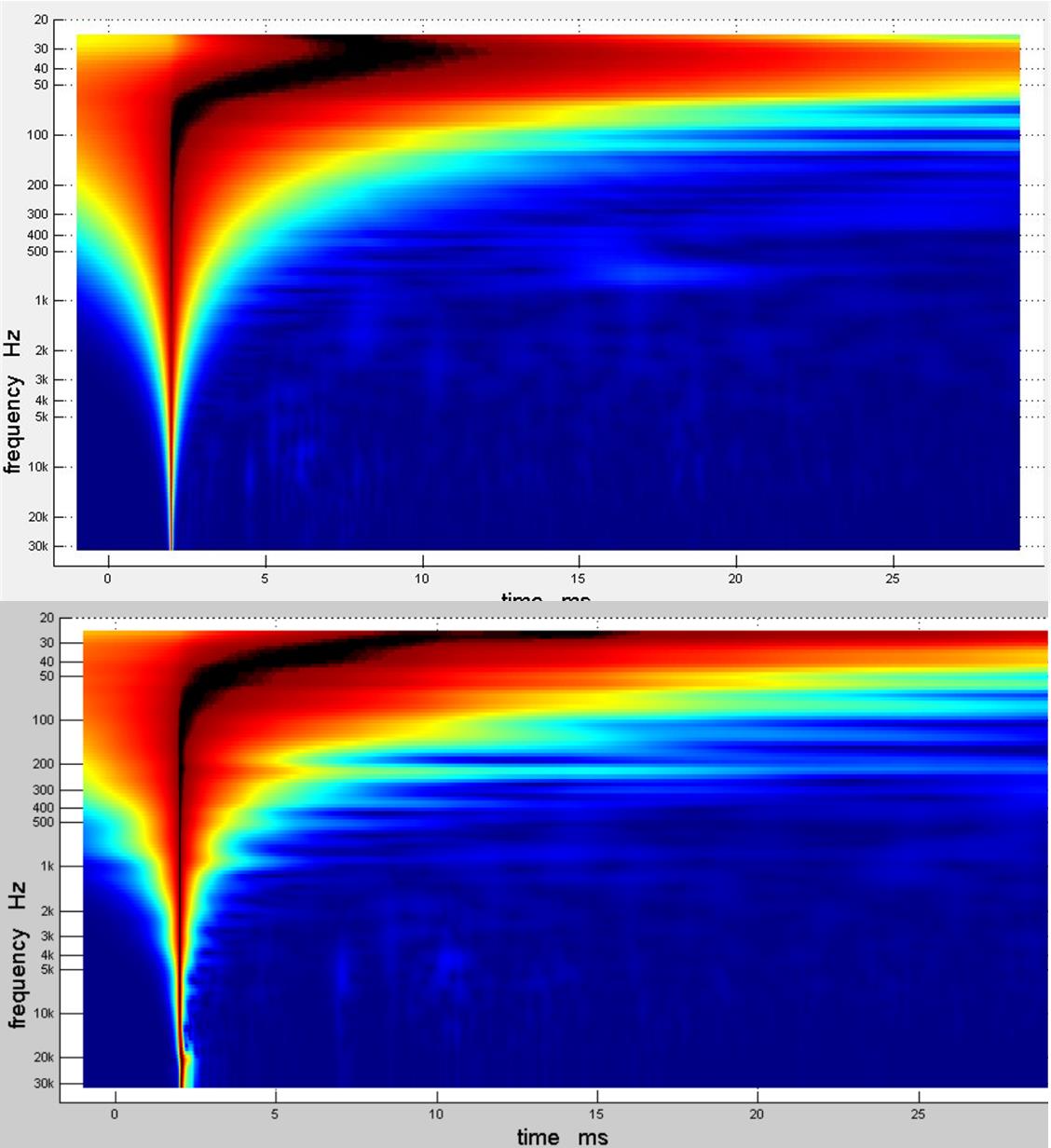
Not even a 1 M measurement will be like that 🙂
Compare that to your graph a page ago:

Then I must have mistakenly posted you a synthetic target rather than the measurement right next to it
I guess so. It's cut short somehow. I'm off for the day. You can upload a new one and I'll see what I can do 😉.
Jack is back .
I'm relieved to report I'm not as absent minded as I feared. I re-imported the exported IR to REW and it looks like a highly smoothed version of the measurement. I then repeated the process this time not checking the box to apply IR windows. This one looks less smoothed but still somewhat smoothed compared to the measurement. My IR window is doing its default 5 cycle FDW. The windows reference time might have been off for the original export. This one I for sure hadn't touched it. New export attached.

I'm relieved to report I'm not as absent minded as I feared. I re-imported the exported IR to REW and it looks like a highly smoothed version of the measurement. I then repeated the process this time not checking the box to apply IR windows. This one looks less smoothed but still somewhat smoothed compared to the measurement. My IR window is doing its default 5 cycle FDW. The windows reference time might have been off for the original export. This one I for sure hadn't touched it. New export attached.
Attachments
.....So the old rule of using EQ to flatten a driver for a couple of octaves past XO and then apply the LPF or HPF should be thrown away and replaced by the above. Its works better and is easier to do when the driver's output falls off so quickly you can't flatten for those one or two octaves.....
🙂 Hmm.. find that statement not the best advice or open minded seen in light for weeks or months XO scheme is still not working as it should, but ofcourse soon things can change and really hope so, from own real world experience can say have exercised both ways of IIR filtering myself and then after that it works flawless upstream put a predicted textbook FIR filter that linearize XO point perfect without having to use any excess paragraphic phase EQ correction.
🙂 Hmm.. find that statement not the best advice or open minded seen in light for weeks or months XO scheme is still not working as it should, but ofcourse soon things can change and really hope so, from own real world experience can say have exercised both ways of IIR filtering myself and then after that it works flawless upstream put a predicted textbook FIR filter that linearize XO point perfect without having to use any excess paragraphic phase EQ correction.
I think the success of either method depends on how flat you can make the FR to apply the textbook filter vs how close you can EQ to the target response.
In a system with drivers that have wider overlap EQ ing flat first may be easier.
In a synergy that method isn't really available because of the acoustic filtering of the bandpass so Jack's comment makes more sense it his situation.
I think wesayso's comments re IIR EQ are spot on and his manipulation of the measurement shows why.
Gmad posted an interesting approach to EQ that could be useful. He used REW auto EQ on a curve that was smoothed with a 1/6 octave frequency dependant window. The auto EQ parameters can be loaded into the mindisp or rephase. As long as there are enough EQ's positions available the curve was very reminiscent of what DRC FIR can do for frequency response.
I can't remember if there is a way to get the frequency dependant windowed part out of DRC FIR, if there is it might could be possible to get REW to auto EQ that and get an even more similar response.
Jack are you able to use linear phase crossover slopes in your minidsp?
This seems to be a good use for linear phase filters as your crossovers are not very low in frequency so shouldn't need too many taps.
If you are it may be possible to need less or no paragraphic phase EQ which seems to have caused a few hiccups.
I find BYRTT's comment strange in light of the fact that he has been a main proponent of EQing drivers to a target curve, providing target reference curves for my use in so doing, and judging the XO's success by how well it matches the target reference summation. perhaps something has been lost in translation along the way.
He may be saying that given the difficulties I've been having I shouldn't be the one to teach methodology. I do want to point out that I only did so reluctantly when asked then characterized my response as "tentative".
Fluid is right that in a Synergy there typically isn't enough overlap to allow flattening EQ first. But even when there is, knowing that your drivers match the target acoustical rolloffs gives you confidence that once you get them time aligned everything will fall into place. In any case, if you want your textbook XO to work according to the textbook, you need to make sure that your drivers follow the textbook acoustical slopes regardless of how you get there.
Much of my difficulty has been in finding that time alignment consistent with correct relative driver polarity and maintaining that through successive stages of filtering that shift the time alignment.
That paragraphic phase EQ started as just a trial; my first use of the technique. When I saw how much correction I was applying I was concerned but completed it anyway to see what the result would look and sound like. It became more than a trial because it sounded so good and looked better than any prior efforts. Now it can use some refinement.
Unfortunately, I can't use linear phase XOs without changing or adding to my DSP hardware. No doubt it would be easier and more EQ resources to boot. Show me a reasonably priced DSP engine with differential audio I/O and maybe I will upgrade. Not likely, I've never known when to quit.
He may be saying that given the difficulties I've been having I shouldn't be the one to teach methodology. I do want to point out that I only did so reluctantly when asked then characterized my response as "tentative".
Fluid is right that in a Synergy there typically isn't enough overlap to allow flattening EQ first. But even when there is, knowing that your drivers match the target acoustical rolloffs gives you confidence that once you get them time aligned everything will fall into place. In any case, if you want your textbook XO to work according to the textbook, you need to make sure that your drivers follow the textbook acoustical slopes regardless of how you get there.
Much of my difficulty has been in finding that time alignment consistent with correct relative driver polarity and maintaining that through successive stages of filtering that shift the time alignment.
That paragraphic phase EQ started as just a trial; my first use of the technique. When I saw how much correction I was applying I was concerned but completed it anyway to see what the result would look and sound like. It became more than a trial because it sounded so good and looked better than any prior efforts. Now it can use some refinement.
Unfortunately, I can't use linear phase XOs without changing or adding to my DSP hardware. No doubt it would be easier and more EQ resources to boot. Show me a reasonably priced DSP engine with differential audio I/O and maybe I will upgrade. Not likely, I've never known when to quit.
Unfortunately, I can't use linear phase XOs without changing or adding to my DSP hardware. No doubt it would be easier and more EQ resources to boot. Show me a reasonably priced DSP engine with differential audio I/O and maybe I will upgrade. Not likely, I've never known when to quit.
I had forgotten that the 4x10 HD had no FIR ability at all. You do have an Open DRC though don't you, for the rephase filter?
If you do you, you already have a minisharc inside. They do have an 8 channel DAC board that will connect straight to it for about $100, not top of the line and not differential but maybe worth a try.
I really don't understand the desire to have a differential output as a prime consideration in a home environment. If your amp has a balanced input you can still use a pseudo balanced cable and get most of the common mode rejection. If your cables are a reasonable length the difference in slight to nil in practice. The differential receiver in the amp is the most important stage in the chain.
I suspect none of that will interest you so I shall just wait to see if you can find another way to get there 😉
Jack is back .
I'm relieved to report I'm not as absent minded as I feared. I re-imported the exported IR to REW and it looks like a highly smoothed version of the measurement. I then repeated the process this time not checking the box to apply IR windows. This one looks less smoothed but still somewhat smoothed compared to the measurement. My IR window is doing its default 5 cycle FDW. The windows reference time might have been off for the original export. This one I for sure hadn't touched it. New export attached.

Here we go:
FR graph:
IR:
Waterfall:
P.S. The ringing in the IR is the conversion between 48000 and 44100. No pré ringing anymore though.
Imported in APL:
The strange bottom end is because the predicted result in DRC-FIR gets cut off. In real life you'd a more gradual bottom end.
Disclaimer: While this result was obtained with DRC-FIR it is using my own templates, none of the standard stuff. I've worked on it for about 6 months and continue to tweak it. It is based on personal preference in listening tests, non standard windowing and exceeding some values. I've shared a previous version once, it should be available in my thread. I've continued working on optimising it though.
I can show you what I do, you'll get ahead when you start to realize why I do what I do.
Attachments
Last edited:
I think the success of either method depends on how flat you can make the FR to apply the textbook filter vs how close you can EQ to the target response.
In a system with drivers that have wider overlap EQ ing flat first may be easier.
In a synergy that method isn't really available because of the acoustic filtering of the bandpass so Jack's comment makes more sense it his situation.
I think this observation is spot on.
Gmad posted an interesting approach to EQ that could be useful. He used REW auto EQ on a curve that was smoothed with a 1/6 octave frequency dependant window. The auto EQ parameters can be loaded into the mindisp or rephase. As long as there are enough EQ's positions available the curve was very reminiscent of what DRC FIR can do for frequency response.
I've always been able to do a better job than REW's auto EQ by hand. Remember to look at the waterfall plots and IR.
I can't remember if there is a way to get the frequency dependant windowed part out of DRC FIR, if there is it might could be possible to get REW to auto EQ that and get an even more similar response.
There is. It's setting is revealed in Gmad's convolution thread somewhere.
Last edited:
Jack, your last attempt is the best yet. As you can see some fiddling can improve it but you're on your way with good crossovers this time.
Now it gets important to keep these results at the listening spot. 🙂
What did you use to align these? Did you use my REW trick?
Now it gets important to keep these results at the listening spot. 🙂
What did you use to align these? Did you use my REW trick?
Any automatic correction could always be improved with some manual tweaking afterward especially when you know how to do it 😉 The auto EQ seems to get fairly close though without much effort meaning more effort can be spent on the tweaking!I've always been able to do a better job than REW's auto EQ by hand. Remember to look at the waterfall plots and IR.
The point was more that you can get some pretty good corrections to use with standard parametric EQ's when the frequency dependant window is used to base it on. Gmad's graphs looked much better to me than I had seen from previous auto EQ attempts and not that far off the sort of curves DRC FIR was coming up with.
When you have a computer to do all the heavy lifting much more is possible. The limits of DSP processors are reached much more quickly and this seemed a good way to get close without much effort. Seems like it could be useful to get a start with EQ for fitting to target curves too.
Looks like I need to read it again. Amazing the basic information your brain remembers without the specifics to be useful!There is. It's setting is revealed in Gmad's convolution thread somewhere.
- Home
- Loudspeakers
- Multi-Way
- My Synergy Corner Horn and Bass Bins
